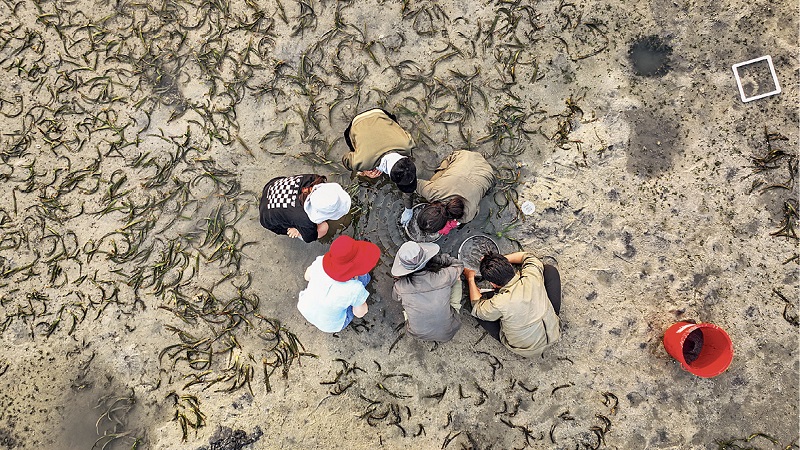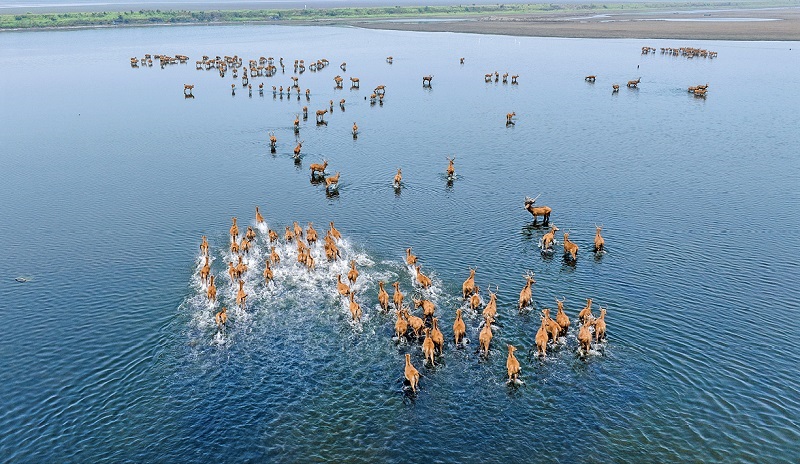The ocean plays a vital role in regulating the global climate. It absorbs the carbon dioxide in the atmosphere and stores it through physical, chemical, and biological processes. The ocean surface dissolves about one third of the carbon dioxide released due to human activities into the atmosphere. Environmental problems such as glacier melting and inundation have become increasingly serious in recent years, and global warming is a climate crisis that all mankind must face and deal with together. The ocean has gained widespread attention because of its ability to absorb carbon dioxide and its huge capacity to store it.

Members of the Blue Carbon Project team conduct a survey on benthic fauna and seagrass in a shallow sea area near Hainan Province in August 2023. Photo by Zhang Mao, a reporter with Hainan Daily
Ocean Carbon Sink
According to Blue Carbon: The Role of Healthy Oceans in Binding Carbon, an assessment report released by the UN in 2009, out of all the biological carbon captured in the world, over half was captured by marine living organisms. Thus the importance of exploring ocean carbon sink cannot be overstated.
According to Dai Minhan, academician of the Chinese Academy of Sciences and professor at Xiamen University, coastal ecosystems, such as seagrass beds, mangroves, and salt marshes, are able to capture and store large amounts of carbon and bury it in sediments for long periods of time. “Developing ocean carbon sinks and improving the capacity of the ocean to capture and store carbon dioxide is an important way to help achieve the goals of carbon peaking and carbon neutrality [dual carbon goals],” Dai said.
As an important part of the ocean, coastal wetland ecosystems play an important role in the ocean carbon sink system as they rapidly and efficiently capture and store carbon dioxide. Over the years, the State Key Laboratory of Marine Environmental Science (MEL) of Xiamen University has accumulated extensive experience in the study of ocean carbon sink, especially in the field of coastal wetland as carbon sinks. The laboratory has carried out a series of basic research, developed technology for carbon sink, and contributed to policy and standard making.
Xiamen University worked with Tencent’s carbon neutrality laboratory and a number of local scientific research institutes and launched the “blue carbon” ecosystem assessment, restoration and accounting project (BLUE-CARE) in 2023. It represents a cutting-edge exploration in the study of coastal wetland ecosystems in a university-enterprise partnership.
The project has selected a number of experimental sites, such as Li’an Port in Lingshui, Hainan Province, Maowei Sea in Qinzhou, Guangxi Zhuang Autonomous Region, and Swan Lake in Rongcheng, Shandong Province. The project team also studied the coastal wetland ecosystems in Beihai, Guangxi and Dongying, Shandong Province, and worked to restore the ecosystems.
Taking biodiversity conservation and community development into account, the team provides demonstration cases and data support for sustainable development of coastal ecosystems, contributing to China’s carbon neutrality goal. “MEL has accumulated a large amount of data on ocean carbon sink in China from onsite observations. The data is crucial to measuring carbon neutrality in the future and the amount of nationally determined contributions to climate change,” Dai said.
Carbon Trading Debut
The core objective of BLUE-CARE is to intensively study the carbon cycling processes of seagrass beds and coastal salt marshes in China, and then build carbon sink measurement methods for these two types of ecosystems. The project also plans to select suitable demonstration areas for seagrass bed restoration, and incorporate the carbon credits it has accumulated during the process into the carbon trading system.
The Yellow River Delta National Nature Reserve in Dongying is one of the main sites for the BLUE-CARE project. The first thing the research team did in the reserve was to restore the ecology of seagrass beds, from optimizing seagrass seeding technology to studying the ecological restoration process, monitoring the restoration process, and evaluating its effectiveness. As of June 2024, the team had successfully restored four hectares of Japanese eelgrass beds through transplantation and seeding techniques.
As a result of the restoration, the number of fish, shellfish, and other marine species in the estuary of the Yellow River is increasing. The team will also calculate the carbon sink capacity of the restored seagrass beds to facilitate “blue carbon” measuring and trading activities, and support the development and maintenance of more “blue carbon” ecological restoration projects.
Xiamen University has important achievements in the compilation of methodology for carbon sequestration of coastal wetland ecosystems. In September 2023, the Carbon Sink Measurement and Monitoring Method for Coastal Salt Marsh Ecological Restoration Project compiled by MEL passed expert review and completed filing at government departments. The work enabled Tencent and Jiangsu Yancheng Wetland and Rare Bird National Nature Reserve to close China’s first carbon trading based on the carbon sink of salt marsh.
In April 2024, MEL’s method for seagrass beds also passed expert review. Since China’s “blue carbon” trading methodology didn’t apply to seagrass beds, MEL’s standards fill a gap in this field and provide a scientific basis for “blue carbon” trading of seagrass beds.
It is a daunting challenge to measure the carbon sink capacity of marine life as marine ecosystems are highly dynamic and extremely complex. “Scientific standards and methods must be followed to ensure the accuracy and reliability of the results,” said Dai. In 2022, China’s Ministry of Natural Resources approved and issued the Measuring Method for Ocean Carbon Sink, which went into effect on January 1, 2023. “The measuring method provides strong data support for carbon emission trading and carbon taxing,” said Dai.

Flocks of wild elks in the Tiaozini Wetland in Yancheng, Jiangsu Province, June 21, 2024.
Tackling Climate Change
Despite being a latecomer, China is on par with its international counterparts in terms of ocean carbon sink study and corresponding application of research achievements. It is also active in international exchanges. According to Dai, China’s efforts in this field are of great value in tackling global climate change and achieving sustainable development. They also demonstrate China’s sense of responsibility as a major country.
The year 2024 marks the 60th anniversary of diplomatic ties between China and France. Chinese President Xi Jinping’s state visit to France promoted cooperation between the two countries in many fields, and one of them was carbon neutrality.
As important signatories to the Paris Agreement, China and France have been playing an active leadership role in addressing climate change. During French President Emmanuel Macron’s visit to China in 2023, China and France agreed to set up the China-France carbon neutrality center. In November 2023, Chinese Foreign Minister Wang Yi and his French counterpart Catherine Colonna attended the center’s inauguration ceremony. In the speech he gave at the ceremony, Wang said that the establishment of the center exhibits an important consensus reached by President Xi and President Macron. The center has been translated from a vision into reality, sending a strong message to the rest of the world that China and France will work together to strengthen cooperation in green technologies and jointly respond to climate change.
In May 2024, China’s Ministry of Science and Technology hosted a seminar on carbon neutrality in Paris, capital of France. With the theme of deepening China-France cooperation on carbon neutrality and climate change response, the seminar promoted global climate governance and sustainable development, and jointly addressed the global challenge of climate change through technological innovation.
Speakers at the seminar shared their insights on the essential role of the ocean in absorbing and removing carbon dioxide, and called on more Chinese and French scientists, government departments, and enterprises to participate in the innovation of carbon-neutral technology to make use of the ocean to remove carbon dioxide.
“In the field of ocean carbon sinks, technical exchanges and research cooperation between China and France are getting closer. Both countries have not only deepened their cooperation in the field of climate change response, but also contributed wisdom and strength to the global green and sustainable development,” said Dai.